The statistics below are based on 99 responses to the questionnaire.
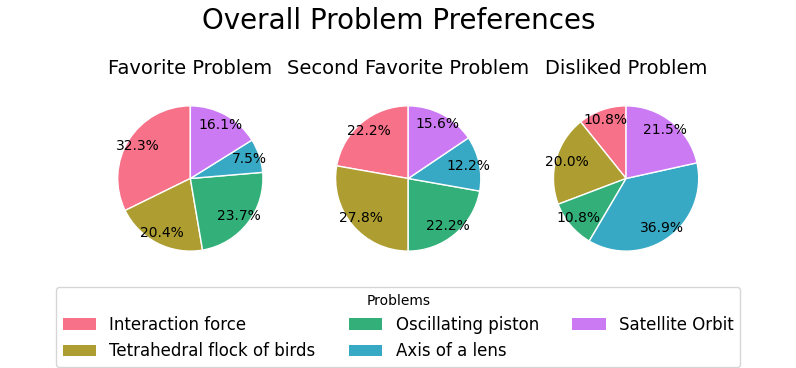
The feedback shows that while every problem appealed to some contestants, each was also disliked by some. Notably, the “Axis of a lens” problem received significantly more negative feedback than the rest. A clear trend emerged where problems that resembled questions from previous Physics Cups were less popular, with “Satellite orbit” being the other notable instance.
The rationale for including “Axis of a lens” was twofold. First, although its setup was similar to older problems, its core solution concept was novel—this holds true for both the intended solution and the alternative homothety-based approach. Second, the aim is to include one optics problem among the five, but the scope for original problem setups in this field is exceptionally narrow. For the Physics Cup format, most wave optics scenarios are either too computationally intensive or conceptually straightforward, severely limiting the degrees of freedom in problem design.
Regarding “Satellite orbit,” it is acknowledged that its central concept has appeared in past problems. However, the execution this year was distinct, requiring a different application of geometry. The “power of a point” is a valuable concept for contestants to become familiar with.
Below are the favorability scores across different contestant groups
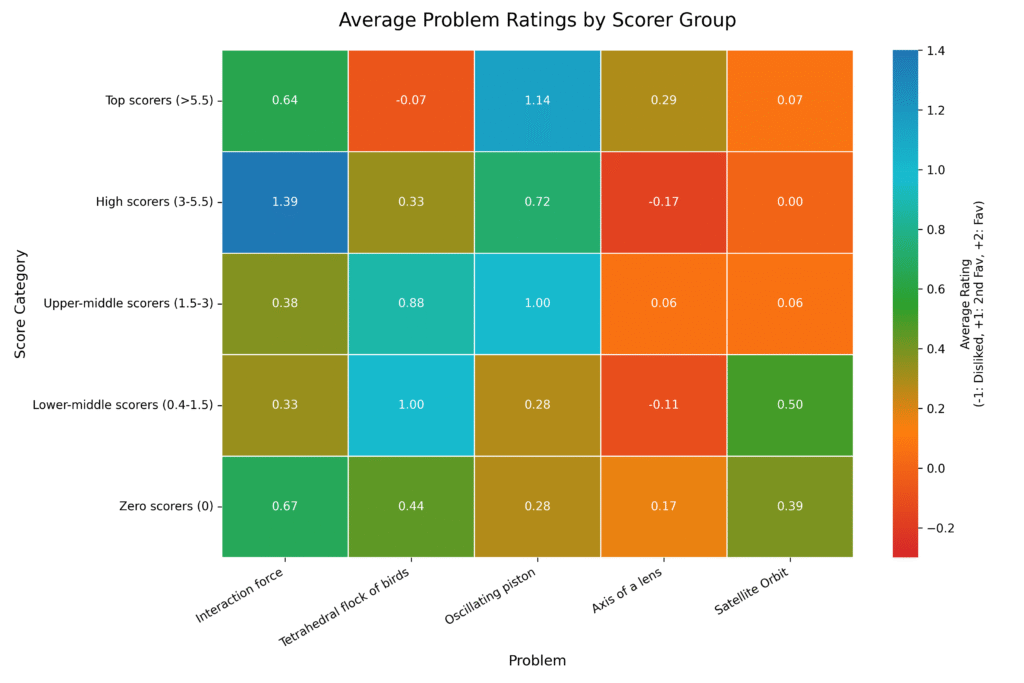
The data reveals a few clear patterns. “Oscillating piston” and “Interaction force” were more appreciated by high-scorers, although “Oscillating piston” was also an outlier in being well-liked by zero-scorers. In contrast, “Satellite orbit” was favored by low-scorers, while “Tetrahedral flock of birds” appealed to all participants except for the high-scoring group.
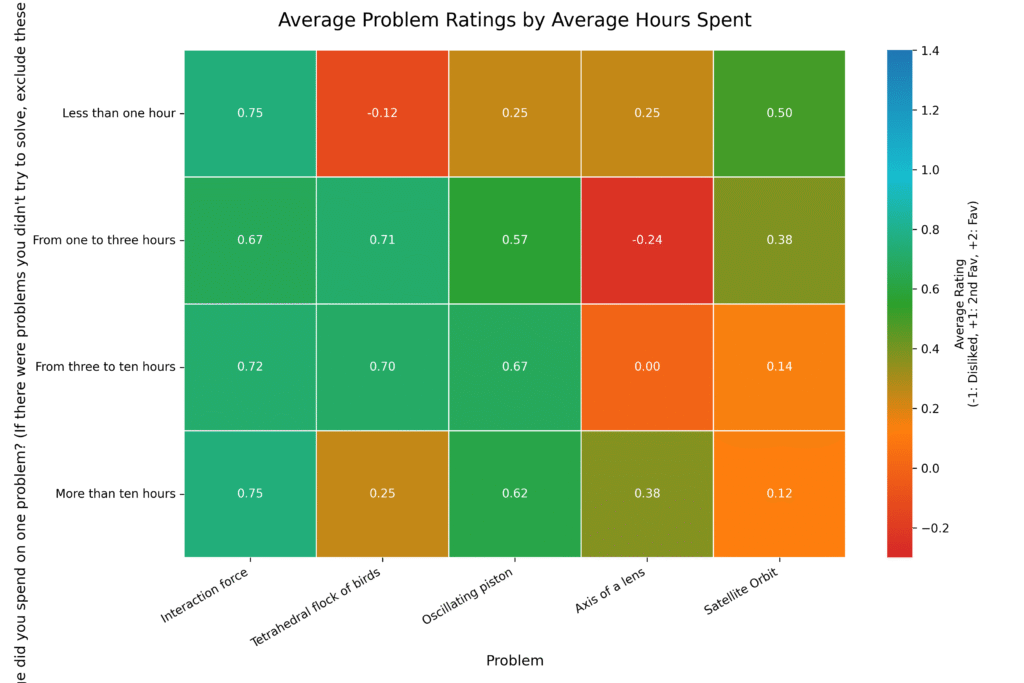
An analysis of the time spent per problem also reveals distinct preferences. Contestants who spent a relatively short time per problem tended to like “Satellite orbit” and dislike “Oscillating piston.” Conversely, “Axis of a lens” was favored by those who dedicated more time to each problem, while “Tetrahedral flock of birds” appealed most to those who spent a moderate amount of time.
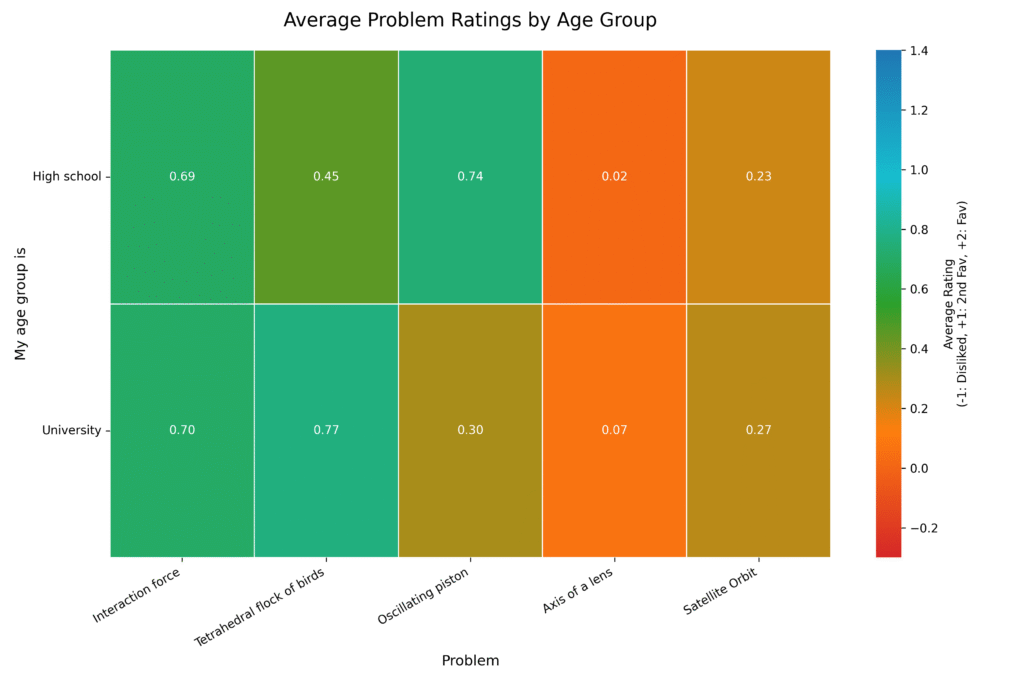
Finally, age group proved to be a negligible factor, with the sole exception being a slight preference for “Oscillating piston” among high school students.
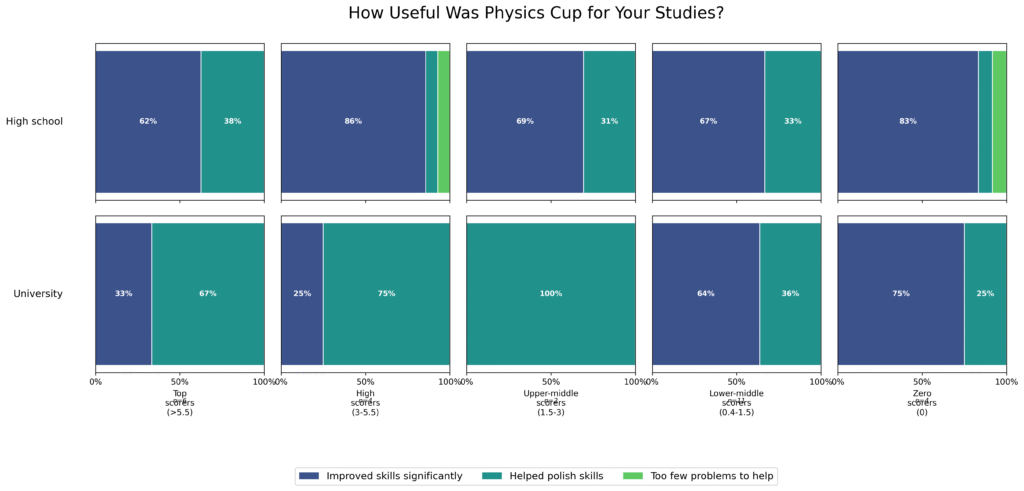
Responses to the question “How useful was Physics Cup for your studies?” reveal that the competition was particularly beneficial for two key demographics: high school students, regardless of their final score, and university students who scored below 1.5 points. More broadly, the competition’s utility was widely acknowledged, with nearly all participants, including high-scoring university students, finding the experience useful.
Comments about the problems from the questionnaire.
Interaction Force
● This was the undisputed best problem this year. It checked a lot of useful EM concepts and took the most time (and energy) for me. The hints were really useful since the problem was so tricky. I was very happy when I finally got it correct!
● It beautifully demonstrated the essence of Newtonian mechanics — how every action has an equal and opposite reaction. I liked the balance between theoretical reasoning and practical interpretation. Solving it gave me a deeper appreciation of how fundamental forces govern motion.
● It had many different solution ways, including a very elegant one.
● Interesting physical interaction and rare to see dependence on distance between two balls
● Consideration of final distribution of charge using dynamics was funny and unusual from classical type of problems in EM and also the resulting force was really interesting.
● I liked the setup and the strong inequalities that simplified the computation. The only downside is that the setup was decently well known online and could be solved more easily using advanced methods. JK – yes, I expected the problem to be much more difficult for the students, but apparently a significant number of contestants found research papers where a conducting ball rotating in magnetic field was considered — that helped them progressing over the conceptually most difficult part of the problem.
● During the solving process I have learned a lot about electromagnetism
● Too much math, could be brute forced
Tetrahedral flock of birds
● This is a problem with a beautiful idea and interesting differential equations.
● This problem greatly illustrates how simple ideas and approaches are crucial for mechanics problems. Also, it constitutes a large break of expectation, as the symmetry isn’t as obvious as in the case of the 2D well-known problem.
● It has wonderful generalizations from the flat case of birds pursuing neighbours of a directed regular N-gon
● It was a nice geometrical problem, I like it because it can be solved in many ways; I had the occasion to discuss it after the publication of the results with some friends who also solved it
● It was a clean, fun, and conceptually interesting problem which was based on physical thinking, and simple algebra.
● Getting the correct symmetries was quite tricky as it isn’t as simple as first expected
● This problem was a great exercise in spatial visualization and 3D geometry. Thinking about how the birds maintain a tetrahedral configuration while moving was a unique intellectual challenge. It was interesting how this combined biological modeling (flocking behavior) with vector calculus or geometric constraints. It required a different kind of thinking than a purely mechanical problem.
I liked it because it was an unusual and clever problem setup. It moved beyond typical 2D physics and required me to apply principles in a complex, multi-object system.
● It was a simple and fun problem with a cool symmetry trick, though the calculations were a bit tedious. What more could you want from a good physics problem?
● I never knew that the birds could move in a way that broke the tetrahedron. But still, there was symmetry.
● The problem is basically just writing down a differential equation and solving it. There is not much of the thought process going around, while for other problems, even to get to the most basic solution, you need outside the box thinking. If you prefer harder problems with more detailed solutions and outbox, this problem is not that great.
● İt was purely mathematical
Oscillating piston
●I really liked using the probability distribution of the molecules’ speeds to solve a thermodynamics questions, especially because such problems are rare, and I’ve gained a lot of interesting insights while solving this problem
● I think it was an interesting problem as it could be approached with many methods and also didn’t require any bashing. Overall it shows a cool phenomenon
● Implied real life scenarios and had multi-concept applications in it too.
● I feel like the difficulty of the problem was very nice. I really like this problem’s use of the Maxwell Boltzmann distribution and the strong inequalities to simplify the calculations. Also, the solution was pretty short if you physically understood the inequalities and setup.
● I enjoyed solving the integrals and all the process that happened in the problem. The careful analyses was for me complex and was very happy when I saw I solved the problem correctly.
● It was both challenging and elegant. It required a clear understanding of oscillatory motion and energy transfer, which made solving it very satisfying
● The problem led me to trying to model the motion of gas in the piston. Even if I realized that this was much too complicated for being the solution to the problem, I kept working on it and got really interesting results.
● I really like how the problem connects momentum transfer with the functionality of the Boltzmann distribution.
● A great problem that focuses on how thermodynamics hinges on the statistical study of microscopic particles
kinetic gas theory is rarely covered in competitions
● The problem felt overly mechanistic and algebraically tedious. The calculations involved in determining the SHM or thermodynamic work were very long and prone to small errors, which distracted from the underlying physics. I felt that the problem didn’t offer as much conceptual insight as others. It was more about following a formulaic procedure rather than developing a deeper understanding of the system’s behavior. The assumptions made about the ideal gas or frictionless motion felt too abstract, making it less relatable or intellectually engaging than the other problems.
Axis of a lens
● Took 4 weeks to solve. Satisfaction.
● I spent the most time on this problem and was solving it for days nonstop. In the process of trying to solve the problem, a learned a lot of geometry along the way and when I finally realised, what the solution was after a week and half, I was filled with joy.
In order to solve the problem I had to understand deeply some important notions of Optics.
● This problem felt like minimal use of physics and more a test on olympiad geometry construction. I think this is fueled by the fact that the idea has been tested before, so a lot of the physical ideas of homothety have been already exposed and revealed. To me, it felt like the same core physics ideas but just a different setup that we needed to construct, effectively making the problem a geometric construction.
● I found the Axis of a Lens problem less enjoyable because it demanded very careful geometrical analysis and accurate ray tracing. Even a small mistake could lead to a completely wrong answer, which made it more frustrating than interesting for me
It felt a bit too technical and finicky — like getting the sign conventions wrong would mess up the whole answer, even if the physics idea was clear. The others felt more like exploring a physical phenomenon; this one felt more like following optical rules carefully. Less “aha” moment, more “gotcha” potential
● It was pretty similar to past problems. Because of that, one could use those as big hints for solving it.
Satellite orbit
● It has a clear and fascinating real-world application. It’s satisfying to use physics principles like Newton’s Law of Universal Gravitation and centripetal force to understand how a satellite stays in orbit. The problem clearly illustrates the balance between kinetic and potential energy in a gravitational field, which helped solidify my understanding of orbital mechanics. I enjoyed the clean mathematical derivation involved in finding the orbital period or velocity, as it brought together several key concepts very neatly.
● The problem could be solved with a lot of math, but the use of Runge-Lenz vector made it way simpler.
● I have always been passionate about the cosmos and the movement of the planets, galaxies have always fascinated me.
● The use of hodographs is rarely seen in problems, so we would certainly like to see more 🙂
● I think that this problem should have definitely not been selected as the fifth problem, because, instead of challenging students’ problem solving skills and creativity, it was a race between those who already knew how to use the Runge-Lenz vector of who could solve the geometry first, as it has been met in previous PC editions.
● I think it was a very standard problem with little room for imagination. Most pcup problems on gravitation can be solved using the LRL vector which is quite boring JK: That’s right, and that is because most of the problems on planetary dynamics – not only those from Physics Cup – can be solved using LRL vector!
● I was disadvantaged because I was at an olympiad for the first hours of the problem, and when I submitted the answer after 2-3 hours, everyone was ahead because the idea was already known. I understand the difficulty of coming up with new problems, but it would be great, if possible, to have problems without such similar ideas. JK: I cannot promise not using problems on old concept as long as new concepts are also involved, but hopefully not more than once per one year (in 2025, there were two such problems).
General comments from the questionnaire
● I want to state that please instead geometrical optics ask more problems on wave optics and if you can ask more on modern physics or statistical mechanics it will be more fun to solve problems. I must confess that i cannot find any motivation to solve last 3 although i was really into to solve first three.
JK: The main selection criterion for PC problems is always creativity and conceptual challenges. That’s what makes topics like wave optics tricky: it’s hard to make a problem that’s conceptually deep when, in most cases, everything just comes down to Fourier analysis. Luckily, the focus on creativity is in line with the need to make LLM-resistant problems, as LLMs (for now!) can’t easily handle such tasks. Statistical mechanics has much more playroom, but can quickly become math-intensive.
But that’s not to say never! If I find a great problem on any of those topics, I’ll definitely use it.
● I think it would be generally good for this contest if the problems didn’t use ideas from previous years, as these aren’t as interesting and challenging when you already know some pretty important steps from the solution just by analysing the best solutions from previous years. Also, maybe after the end of the contest, there could be “bonus problems”, some of the existing problems which were not selected and will not be used in the future, but still could be a fun challenge for training and understanding certain topics better (kind of like problem 0 in the first editions of PC).
JK: as said above: I cannot promise not using problems on old concept as long as new concepts are also involved, but hopefully not more than once per one year. As for “bonus problems”: EuPhO and NBPhO need good problems, so many problems are kept in waiting list. But if there is a problem not suitable for any of those, I’ll publish it as a bonus problem.
● The cutoffs were simply too high.
JK: it comes down to our budget. We’ll increase the number of awards when we can afford it.
● Please increase the difficulty level of the problems significantly. This year, due to the open public access of powerful LLMs and AI models, many candidates took unfair advantage of such tools in order to solve the problems correctly. Other than that, I hope you’ll maintain the quality of problems (if not increase it) in the upcoming years.
JK: yes, LLMs limit our playroom. In 2025, the first problem was affected: LLMs helped finding the useful papers on the topic of the problem. We’ll keep eye on this fact.
● The problems this year were excellent and very thought-provoking. Please maintain this high standard of creative and challenging problems. While I appreciate the need for a faster solution process, I quite like the bonus points rule. I believe it puts less emphasis on the more subjective parts of the contest like the best solutions and time bonuses. This way, the contest is more objective and impartial. I think the only downside is that it boosts the top participants a bit too much. The people who solve all 5 problems are already getting roughly 5 points so giving them more just inflates the scores. Thus, I think the rule is good but maybe the points should be less (0.25, 0.5 and 1 maybe).
JK: thanks! This might be a good compromise!
Related to this, I feel like the release times of the problems should be different for each problem. In particular, the problems were always released at 5 am for me. So, for the last problem, since it was so easy, I didn’t get any time bonus even though I solved it within 1 hour of waking up. To make it more fair, I think releasing the first problem at 0:00 UTC, the next one at 5:00 UTC, the next at 10:00 UTC, etc. is more fair for people across time zones.
JK: we’ll consider this option.
● The only 2 things I would like to suggest is, that more people should deserve a silver or gold medal, based on the total number of participants, how many people solved the problems and total number of bronze medals awarded. My comment is based on the fact that, in the final scored, only 4 people got platinum+gold, only 5 silver, but the total of 30 bronze medals were awarded. For me personally, this ratio of medals does not make any sense and hence I strongly believe there should be at least 3 more golds and 4 more silver medals in the graduate section. The second thing I wanted to point out is something I mentioned in one of the previous questions: the best solution bonus should be split between graduate and undergraduate students. Some people are faster than other but also, their solutions are less detailed. Some people are exact opposite; they seek more detailed solutions, with numerous details, yet they are not so quick. Hence I strongly believe, each aspect of problem solving, the speed and the quality, should be equally represented in the form of bonus points.
JK: As said before, number of awards depends on the budget; we’ll increase the number of awards when we’ll be able to do so. Quality versus speed: this is exactly the reason why we have “best solution awards”. However, speed is objective, and quality is subjective, that’s why I don’t want to increase the amount of quality points as that would increase the relative weight of subjectiveness. Also, I want to be as objective as possible in distributing the quality bonus points and that means I need to study and compare all the submissions carefully, and that takes much more time than just figuring out if the solution is correct or it has mistakes. To sum up, with only me running this competition, increasing the weight of quality bonus is not feasible.
● At problem 3, I made a mistake in my calculations, counting a multiplication of 2, twice. However, no other logical or physical mistake was made. If I had not made that mistake, I would have been the 5th to solve it. Because it was a problem with a lot of calculations, I am biased to consider that maybe it would have been fair for me to get the time bonus, while having a 0.9 or 0.95, similar to the policy of Problem 1. But, in general, thank you for this nice contest.
JK: In principle, I agree with you: that was a minor mistake, and it would make sense to reduce the penalty it carries. However, the format and rules of the Physics Cup were designed to be scalable, so that one person can keep it running even when the number of submissions per week reaches triple digits. Figuring out if a mistake was minor or major takes time, and besides, where do we draw the line between the two? That’s why the rules allow you to resubmit a corrected solution for a minor penalty. So, my recommendation is that when you go for the speed bonus, send your answer-only result as fast as possible, and then double- and triple-check your solution for possible typos. If you do that fast enough, you can still get a speed bonus even after fixing a typo, with the minimal 0.95 penalty for a self-corrected mistake. (In cases where a mistake in the exact prefactor is almost certainly due to a typo, a special penalty rule is usually announced, as was the case with Problem 1. For Problem 3, however, a conceptual mistake could also result in an incorrect prefactor, so it was impossible to judge from the answer alone whether the error was just a typo.)
● There should be no extra points given for the best solutions, although they still should be announced. The reason for that is solving a problem should be the important action here rather than just writing it in latex or even though you do not cancel the extra points due to best solutions, I believe lowering these extra points is also a good solution.
JK: I believe that a very creative solution deserves more points than a standard one. Furthermore, the best solution awards have proven to be a very efficient way of improving presentation quality, turning the contestants’ solutions into a valuable study resource for other students. So, the best solution awards are here to stay.
● I found the 2025 competition absolutely amazing. It has been my first Physics Cup, thus i cannot compare it with other editions, but I didn’t found the delaying of the final results a problem at all.
JK: Thank you!
● I would enjoy seeing a problem that include so many aspects, tricks, ideas. One great example is fastest lap problem which I enjoyed a lot while solving.
JK: That is one of my own favorite problems, too! Don’t worry, all the good problems will get published eventually – either here or at EuPhO.
● In Cuba, the Commitment of Physics Olympiad uses PC problems in training, for us is the hardest Physics Competition in the world. Thanks for your work.
JK: Glad to hear, thanks!
● Physics Cup is my favourite competition. Differently from timed exams (such as IPhO, APhO, USAPhO), it allows creativity to shine. Because it frees the students from any time or algebraic pressure, it focuses on the actual physics and its bright ideas. A special thanks to professor Jaan Kalda for coming up with such amazingly fun competitions that perpetuate this view (PC, EuPhO, NBPhO)
JK: Thank you! NBPhO was originally launched as a selection competition for Estonia and Finland. Big nations can afford to select mature candidates who already possess both advanced skills and creativity. Meanwhile, it was my belief that small nations cannot afford to miss anyone with great creative potential; advanced skills are much easier to teach than creativity. The problems at IPhO and APhO (or at least a major part of them) have their own merits—they often teach an interesting phenomenon by guiding you along a path devised by the authors. However, as these problems become longer and more complex, solving speed can overshadow creativity. While speed is certainly important for a physicist, it is far less critical than creativity for those aspiring to make major contributions. This is particularly true in the era of LLMs.
● Give some ranking for individual countries as well. Everything is great.
JK: There are big and small countries, so their results are difficult to compare fairly. For that reason, let’s keep the competition individual. However, you are always free to compile your own country rankings.
● Solving problems by writing them manually on an A4 list seems appropriate to me, so I would like to do this, that is, write the solution manually on an A4 list, take a photo with the CamScanner application and send it to you.
JK: That’s fine—just keep in mind that with such solutions, your chances of receiving a best solution award are lower. Then again, nicely typesetting a solution is no guarantee of an award either.
